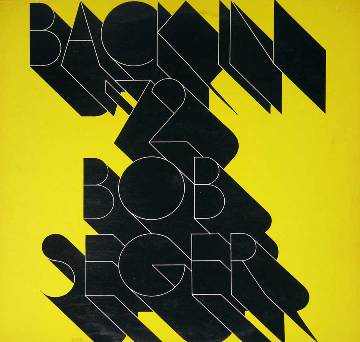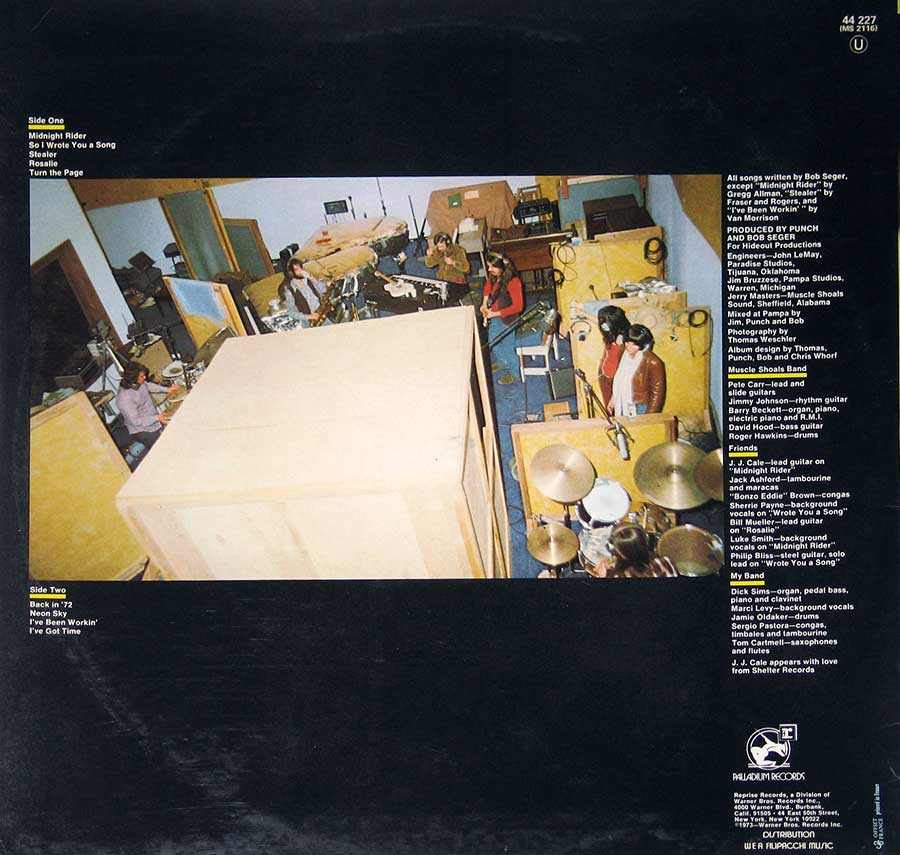
Bob Seger Back in '72
Classic Rock Album Review
CURATED BY INTERNATIONALLY RECOGNIZED ROCK JOURNALIST JIM ESPOSITO
Bob Seger's First Great Record Album
Back in '72
Fresh Perspectives on Notable Classic Rock Records

Back in '72
Bob Seger
Released 1973
Palladium Records
by Jim Esposito
Bob Seger’s long lost album Back in ’72 turned 50 last year. Many people have never heard this record, but it was Seger’s first great LP. His sixth released, it marked a turning point in Seger’s career as he went from being a bar band to a national act, from a singles band to an album artist.
Unfortunately, it has never been released as a CD. Seger himself blocked that. Over the years we heard a number of reasons. Bob did not like his vocals. We always assumed it was because Back in ’72 contained the original studio version of “Turn The Page,” which would’ve cut into the sales of Live Bullet, since that double LP featured a clean concert performance of the tune which got a lot of airplay.
Either way, when we feel like hearing some Bob Seger, and it’s not Night Moves (his master work) we’re usually digging out Back in ’72.
There are personal reasons this album ranks high in my book, I must admit. Just starting out as a Rock Journalist, Bob Seger was one of the first interviews I ever did. Talking to him as he’s stretched out across an unmade bed in a seedy concrete motel in Sunny Isles, Seger spoke about his upcoming album, Back in ’72. It therefore became a milestone in my life, easy enough to remember where I was that year.
The only track Seger mentioned was Van Morrison’s “I’ve Been Working.” “I’ve got a good jam” for that tune, he told me. The only Van Morrison song Seger ever recorded, we do see traces of “Tupelo Honey” in “Main Street” off Night Moves – the same structure, four repeating chords over which you sing some rather free-form lyrics.
He knew the album title, so he must’ve written the title track at that point, because we did discuss ’72 – the year. Bob said it was a kinda nuthin’ year. Where nothing really major happened. And that is reflected in the lyrics. “When the waters cleared it was what we feared, we learned nothing new.”
Back in ’72 was the first time Seger recorded part of his record at the fabled Muscle Shoals Studios a modus operandi he would continue through subsequent albums. Also, it was the first time Seger employed the services of Alto Reed on sax.
What makes Back in ’72 is the strength of the material. It’s hot, fresh, spontaneous and unpolished. There are no bad songs on this record, no skippers you don’t wanna sit through. This is where Seger’s songwriting turned the corner. Before this he’d only written one good tune. (“Ramblin’ Gamblin’ Man”). He’d gotten local airplay with “East Side Story,” “2 + 2” and “Heavy Music,” which were decent, but Bob Seger took some years to develop. Back in ’72 is where as an artist Seger steps up onto the national stage.
Born in Detroit, Seger was first heard in a band called The Decibels in 1961. He was 16. His first studio album, Ramblin’ Gamblin’ Man, was released by Capitol in 1969. The only standout track is the title tune, originally a single the year before, hitting #17 on the Billboard Charts, featuring acoustic guitar and backing vocals by a heretofore unknown musician named Glenn Frey (his first studio gig). Subsequently the Bob Seger System released Noah and Mongrel on Capitol before Bob decided to go solo and record Brand New Morning with no band, just himself on guitar, vocals and piano. In 1972 he released Smokin’ O.P.’s, an album of predominsntly cover songs including “Bo Diddley/Who Do You Love,” “Let It Rock,” “Turn on Your Love Light,” Stephen Stills’ “Love The One You’re With” and Tim Hardin’s “If I Were a Carpenter” (a big hit for Bobby Darin), which actually got some airplay, peaking #76 on Billboard’s Hot 100.
Some interesting Rock Archaeology if you care to take the time, give this stuff a listen, but it’s raw, unfocused. Ramblin’ Gamblin’ Man is actually Psychedelic Rock. Perhaps most notably Bob’s doing his own lead guitar. Seger emerged from, eventually came to personify the driving hard-edged rock sound of Detroit, a music scene which gave us bands like Mitch Ryder & The Detroit Wheels, the MC5, Iggy and The Stooges, Grand Funk, Del Shannon, Ted Nugent & The Amboy Dukes, Tommy James and The Shondells, Rare Earth, Brownsville Station, Question Mark & the Mysterians, Cactus, Suzi Quatro, Alice Cooper and – not to mention – Motown.
Meanwhile, nobody worked harder than Bob Seger. On the road, touring constantly, over 200 gigs a year, the guy played bars, pubs, taverns, saloons, roadhouses, high schools, college auditoriums, frat parties, hotel ballrooms, small halls, Moose Clubs – you name it. I saw him once (have a great little hang-out piece posted on Rock’s Back Pages dot com) playing on the roof of a projection hut at a drive-in theater across the street from Fort Lauderdale International Airport – in the rain, jetliners coming in for landings a couple hundred feet overhead.
Over the years Seger built up a following in several geographical pockets around the country – Michigan (naturally), but also upstate New York and South Florida. With his guitar based rock, blue collar image, his raspy, growling vocals, the man worked hard. Seger put on a good show. “And every ounce of energy, you try to give away…” You rocked. You rolled. You stomped your feet. You clapped your hands. So you bought his records, listened, and you thought – well, he puts on a good live show.
That all changed before vocals come in on the title track, “Back in ’72.” Though liner notes are not specific this was almost certainly done in Muscle Shoals with Pete Carr on guitar. It is hot. The beat starts a-thumping, then the lead guitar comes searing through like a freaking laser beam. A bit of a travelogue, a bit of a retrospective, the lyrics tell a simple tale, but pack a punch.
Tricky Dick, he played it slick
Something I was afraid he’d do
Back in ’72
Pay attention to Pete Carr’s guitar. A stellar performance, he oozes from a relentless hard-driving rhythm into great fills and transitions, manages to squeeze in a couple short, tasty solos.
After relating a number of scenarios, Bob wraps it up in his third verse:
It was so hip to be negative
So square to try and believe
When the waters cleared, it was what we feared
We learned nothin’ new
Back in ’72
The second outstanding tune on this album is “Rosalie.” Later covered by Thin Lizzy in 1975 it is a commentary on the music business. Rosalie Trombley was Programming Director for CKLW-AM out of Windsor, Canada. Right across the river from Detroit, but not hampered by FCC regs, it’s signal blasted across the U.S., dominating the airwaves. “From Chattanooga to good ole’ Bogalusa.” Through that era airplay was everything and Programming Directors wielded incredible power. They played your record, you were made. That’s why payola and bribery scandals usually involved Programming Directors.
A fun track with an infectious rhythm and melody, this is another song where lyrics and music merge perfectly into three-dimensional poetry. Lead guitar is credited to Bill Mueller (a.k.a. Blue Miller, and another interesting exploration into Rock Archaeology if you have the time). Through the years Seger illustrated he was not above a little biting social commentary – such as “2 + 2,” “UMC” and “Long Song Comin’” off Seven, “Making Thunderbirds,” “Back in ’72” itself. In “Rosalie” Bob does not mince words.
She’s got the power,
She’s got the tower,
Rosalie
She makes the choices
And man you best be smiling when it’s choosin’ time
Rosalie
Oddly enough, “Rosalie” never made it onto the playlist at CKLW-AM.
The third great cut on this album is “Turn The Page,” the original studio rendition which became one of Bob Seger’s most enduring numbers, perhaps THE most definitive song about the rock ’n roll life on the road. To this day it is one of Bob’s most beloved. It tells you about the life, it tells you about the artist. Probably nobody in rock spent more time in cars on long and lonesome highways east of Omaha, north of Yeehaw Junction, west of Buffalo, south of Ann Arbor.
As always, as he developed into the songwriter he was becoming, Seger puts it all into perspective at the end.
Out there in the spotlight you’re a million miles away
Every ounce of energy you try and give away
As the sweat pours out your body like the music that you play
Later in the evenin’ as you lie awake in bed
With the echoes of the amplifiers ringing in your head
You smoke the day’s last cigarette, remembering what she said
This was a theme Seger returned to in “Travelin’ Man” and “Sunburst.” Many other artists penned similar songs, for it was the half-Gypsy, half-circus life they lived. Skynyrd did “Roll Gypsy Roll.” Jackson Browne did “Runnin’ On Empty.” Creedence did “Travelin’ Band” and “Lodi.” Grand Funk did “American Band.”
Two other highlights on Back in ’72 are covers: the aforementioned “I’ve Been Working” and “Stealer,” a song by Free.
Seger talked about the former when I’d interviewed him in 1973. At that time he told me they had a good jam worked out to the tune and they were going to record it at Leon Russell’s studio. Some sources on the internet suggest Pete Carr plays lead on the tune, but this actually might be Seger himself, assuming they actually did record it at Leon Russell’s studio. Three tracks on Back in ’72 were recorded at Muscle Shoals. Of the seven remaining, guest guitarists are credited on three. It’s a hot tune, but it doesn’t sound like Pete Carr’s guitar lines, and Seger did do his own guitar on his early LPs.
“Stealer” is a cover of a Free song written by Paul Rodgers, Paul Kossoff and Andy Fraser. Off their fourth LP, Highway, “The Stealer” was their follow-up single to smash hit “All Right Now.” It did not do too well and Highway tanked, but Seger’s rendition is great, very hot. His vocals suit a Paul Rodgers tune quite well, and “Stealer” is almost certainly another tune recorded with the Muscle Shoals Rhythm Section. In addition, it is not too wild to suggest in “Stealer” you can hear the roots of “Come to Poppa” off Night Moves.
As mentioned before, three songs on Back in ’72 were recorded using The Swampers, though which are not specified in liner notes. For my money it is the title track, “Stealer” and “Neon Sky.”
Meantime, for those keeping score, we have just singled out five cuts from Back in ’72 as “great.” There are nine songs on the album. So you do the math.
Of the other four cuts, three are ballads written by Seger: “Neon Sky,” “So I Wrote You a Song” and “I’ve Got Time.” All pretty good. The fourth is a cover of Gregg Allman’s “Midnight Rider” with J.J. Cale on lead guitar. A little more up-tempo than the Allman’s version, next time I ran into Seger I asked him about recording with J.J. Cale, a particular hero of mine, who didn’t do much session work. Bob told me he didn’t have much discourse with Cale. J.J. came in, did his guitar part, didn’t hang out.
These days about the only way you can hear Back in ’72 is to go to YouTube. It’s certainly worth the time. To me it is a demarcation between Seger’s early work, his first good album. It might be a little raw, but there’s a spontaneity you simply don’t find in some of his later work. Night Moves is a masterpiece, one of the very few “perfect” albums in Rock History. Succeeding records by Seger usually contained one or two great songs, but there aren’t many you enjoy the whole way through. Against The Wind is probably his second or third best LP, but the other I really like is Seven. Released in 1974, right after Back in ’72, it is one of Seger’s best pure rock albums. “Get Out of Denver” got some airplay, but Seven features lead guitar by Jim McCarty of Cactus and Drew Abbott, who played for The Silver Bullet Band until 1983.
We’:d also be remiss if we didn’t mention the album cover. Obviously done on the cheap, however, the photo on the back cover is priceless: an overhead shot of Seger and his band recording in what we presume is Leon Russell’s Paradise Studios. That was rock ’n roll, baby.

Classic Rock Updates
Sign Up For Our Email List!
Receive a Notification When New Content Is Posted
Email Your Email Address to jim.classicrockforever (at) gmail.com
We do not SPAM. You will receive one email every week or two.
We will never sell your email address and you can easily unsubscribe at any time.
Help Support Our Site
Shop Amazon through Classic Rock Forever
Amazon.com
Click on Link, go to Amazon, search for whatever you want. We'll get credit.
Classic Rock Updates
Sign Up For Our Email List!
Receive Notification When New Content Is Posted
Email Your Email Address to
jim.classicrockforever (at) gmail.com
We do not SPAM.
You will receive one email every week or two.
We will never sell your email address and you can easily unsubscribe at any time.
Help Support Our Site
SHOP
Amazon.com
through
Classic Rock Forever
Amazon.com
Click on Link above, go to Amazon, then search for whatever you want.
We'll get credit.
Make Sure You Visit
Our Friends at
The Ultimate Online Library of Classic Rock Journalism
Over 40,000 Articles
The World's Biggest Archive of Stories, Interviews & Reviews
From Allmans to Zappa
Click Here
Listen To Audio
Jim Esposito's
Explosive Interview
with
Ritchie Blackmore
Deep Purple's Somewhat Tempermental Guitarist Dumps The File in 1973
Click Here
“Second Best Interview in Rock ’n Roll History”
Grace Slick
Rambles On
(And on and on
and on and on...)
Click Here
The funniest book you'll ever read!
High in The Sky Over Florida
Very High
by Jim Esposito
“Like the weirdest guy I ever met.”
– Grace Slick
Available Now on Amazon!
Click Here